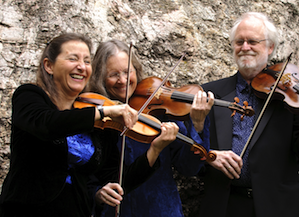
Photo by Katja Zuske/Katzprints Photography
The next series of programs from the period-instrument ensemble New Esterházy Quartet, March 21-23, features "music from 19th-century Vienna never heard before in the Bay Area," says the press release.
The premiere is British professor William Drabkin's recent completion of Haydn's unfinished Quartet in D Minor, Op. 103 (1803). The program's two "almost-certain Bay Area premieres on gut strings" are Schoenberg's Quartet in D Major (1897), and Schubert's Quartet in G Major (1826).
Haydn's last quartet, Op. 103, has been known for over 210 years as incomplete. There are a few sketches for what apparently would have been the first movement, had advancing age and exhaustion not stopped Haydn's composing before he could carry out his plans for the quartet. It was to have been the third of a set commissioned for Prince Joseph Franz Maximilian Lobkowitz, for whom Beethoven at the same time wrote his first set of quartets.
Violinists Lisa Weiss and Kati Kyme, violist Anthony Martin, and cellist William Skeen — all prominent in the Philharmonia Baroque and American Bach Soloists — have propelled the quartet into the forefront of world's top period-instrument string quartets, certainly with Haydn's 68 quartets as their core repertoire.
As to the other works on these concerts, says the announcement:
It seems unlikely that Schubert's Quartet in G Major (1826) was played here a century ago, before steel and plastic replaced organic materials in string manufacture. The piece was long considered too challenging for performers and audiences alike, and it found little favor until championed by the Busch Quartet in the 1930s.
Not so fast, says violist Michelle Dulak Thomson, who writes for SFCV:
This will not be the first period-instrument performance of the Schubert G Major in the Bay Area. The Berkeley Schubert Quartet was formed in 1997 to do all the Schubert quartets — even the very early and (in some cases) comically craptastic ones — for the bicentenary, and they did.Two of the members of that ensemble (Lisa Weiss and Tony Martin) are in the New Esterházy. The others were Leighton Fong (cello) and George Thomson (second violin).
The tentative claim of "first" for the Schoenberg may stand, unless evidence is presented to the contrary:
Without officially claiming a premiere for Schoenberg's early Quartet in D from 1897, it is almost certain that this will be the first time it has been heard in the Bay Area on the gut strings for which it was written. The outer movements of this strongly tonal, melodious Quartet in D sound very much like Dvořák, the inner two like Brahms. Although Schoenberg never allowed this work to be published, he must have thought enough of it to preserve it, unlike earlier quartets he is known to have written but of which no traces remain. The New Esterházy Quartet uses a corrected edition by Henk Guittart of the Schoenberg Quartet of Amsterdam.
Audiences are invited to discuss the music after performances on March 21 at the Hillside Club, Berkeley, on March 22 at St. Mark's in San Francisco, and on March 23 at All Saints' in Palo Alto.
Late update: the quartet's newsletter yesterday got the Schubert history right —
Schubert's massive, majestic, and mystical G Major Quartet, written in 1826, two years before his death, had its Bay Area premiere on gut over 15 years ago by the Berkeley Schubert Quartet, with Lisa Weiss and Anthony Martin of the New Esterházy Quartet playing first violin and viola. Of course it is possible that the piece was also played here a century ago, before steel and plastic replaced organic materials in string manufacture. However, that seems unlikely, since it was long considered too challenging for performers and audiences alike, and it found little favor until championed by the Busch Quartet in the 1930s.

